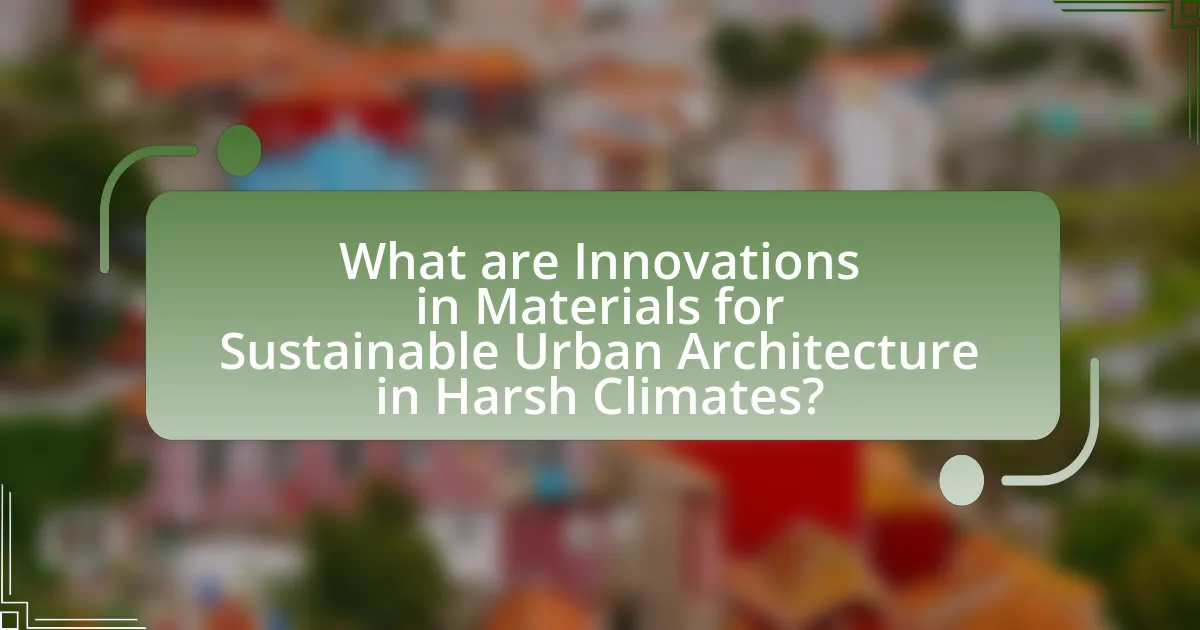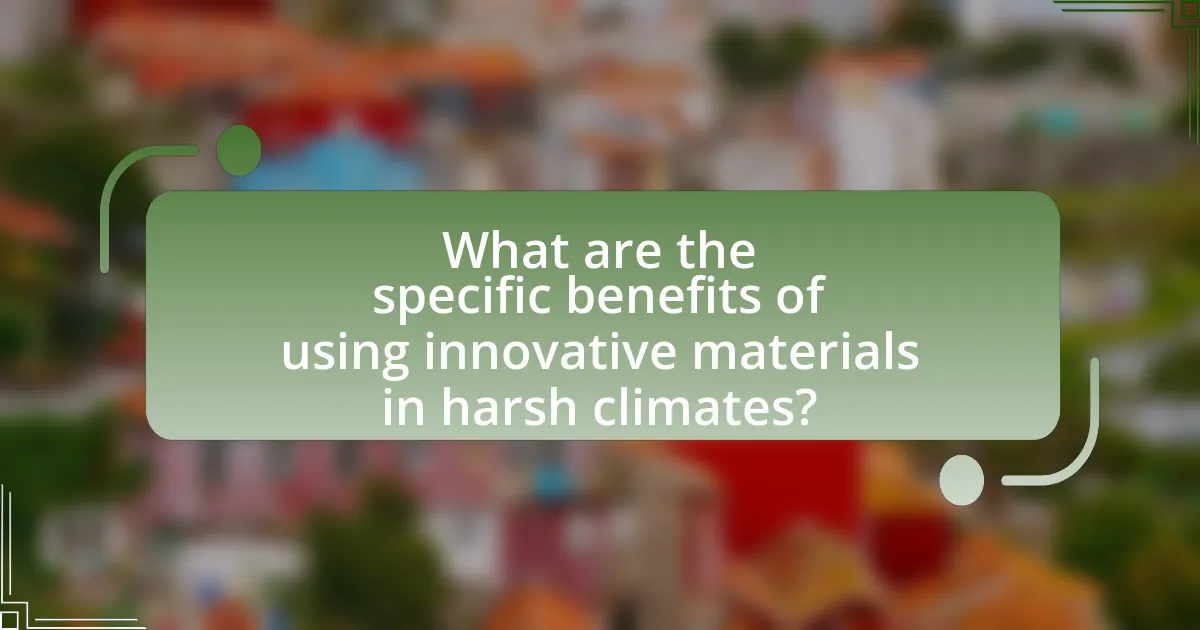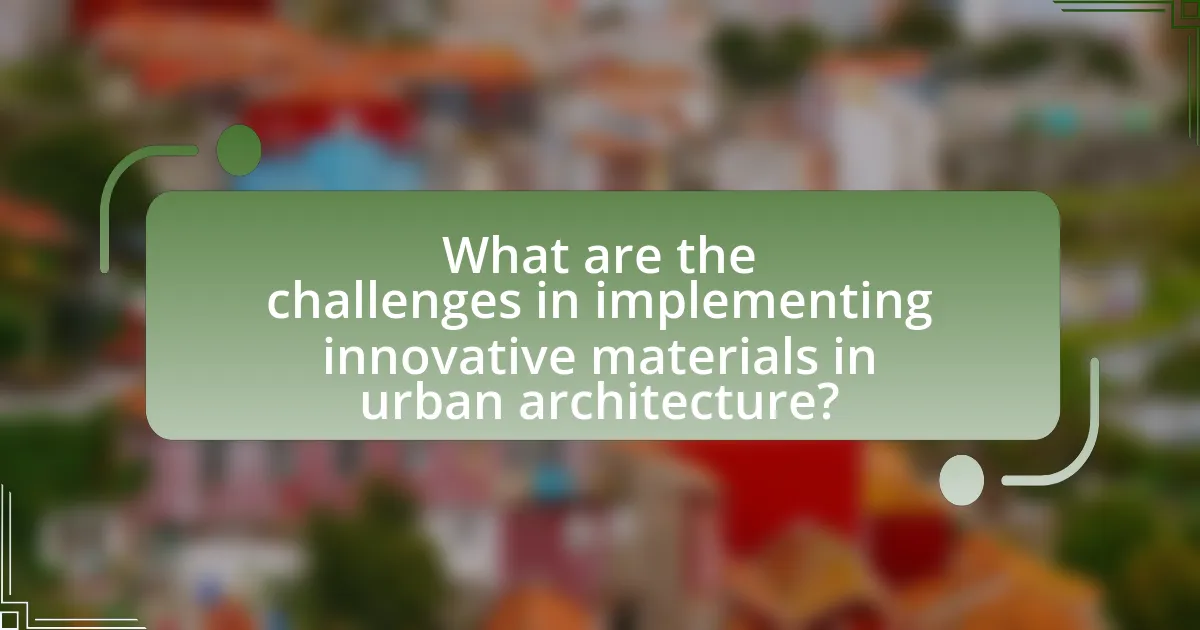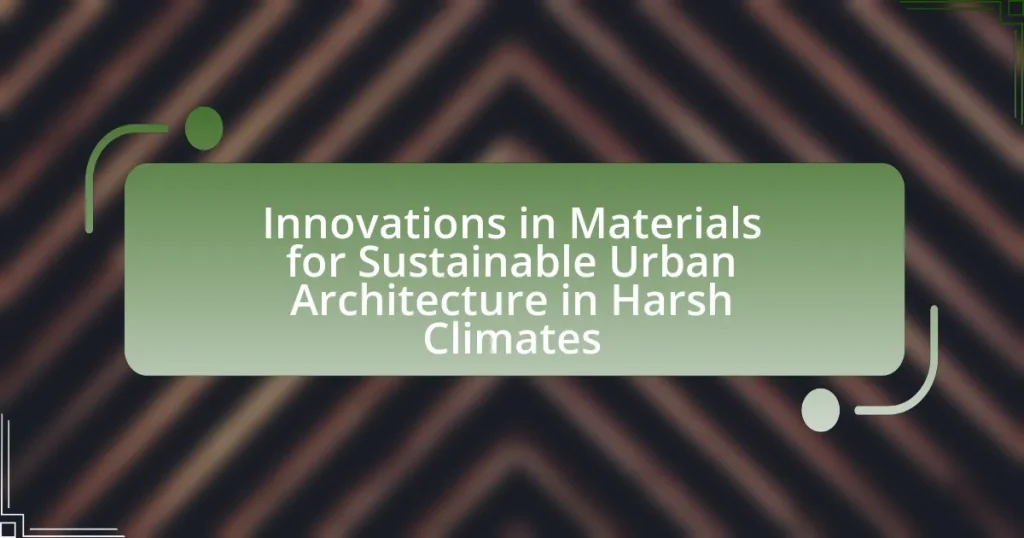Innovations in materials for sustainable urban architecture in harsh climates focus on advanced insulation, reflective coatings, and durable concrete formulations that enhance energy efficiency and environmental resilience. High-performance insulation materials, such as aerogels, significantly reduce energy consumption, while reflective coatings minimize heat absorption in hot climates. Additionally, the use of recycled materials and self-healing concrete addresses durability and environmental impact, leading to energy savings of up to 30% compared to traditional methods. The article explores the specific climate challenges urban architecture faces, the characteristics and benefits of innovative materials, and the economic and health advantages associated with their adoption. It also discusses the barriers to implementation and strategies for promoting these sustainable solutions in urban design.

What are Innovations in Materials for Sustainable Urban Architecture in Harsh Climates?
Innovations in materials for sustainable urban architecture in harsh climates include the development of high-performance insulation materials, reflective coatings, and advanced concrete formulations. High-performance insulation materials, such as aerogels and vacuum insulation panels, significantly reduce energy consumption by maintaining indoor temperatures despite extreme external conditions. Reflective coatings, which can be applied to roofs and facades, enhance energy efficiency by minimizing heat absorption, thus lowering cooling costs in hot climates. Advanced concrete formulations, including self-healing concrete and those incorporating recycled materials, improve durability and reduce the environmental impact of construction. These innovations are supported by research indicating that buildings utilizing these materials can achieve up to 30% energy savings compared to traditional construction methods, demonstrating their effectiveness in promoting sustainability in challenging environments.
How do these innovations address the challenges of harsh climates?
Innovations in materials for sustainable urban architecture address the challenges of harsh climates by enhancing energy efficiency, durability, and adaptability of structures. For instance, advanced insulation materials reduce heat loss in cold climates and minimize heat gain in hot climates, leading to lower energy consumption for heating and cooling. Additionally, weather-resistant coatings and materials, such as high-performance concrete and reflective roofing, improve the longevity of buildings by protecting them from extreme weather conditions, including heavy rainfall and intense sunlight. Research indicates that buildings utilizing these innovative materials can achieve up to 30% greater energy efficiency compared to traditional construction methods, demonstrating their effectiveness in mitigating the impacts of harsh climates.
What specific climate challenges do urban architectures face?
Urban architectures face specific climate challenges such as extreme temperatures, increased precipitation, and rising sea levels. These conditions necessitate the development of materials and designs that can withstand thermal stress, manage water runoff, and prevent flooding. For instance, cities like Miami are experiencing more frequent flooding due to sea-level rise, prompting architects to incorporate elevated structures and permeable materials to mitigate water damage. Additionally, urban heat islands exacerbate temperature extremes, requiring innovative cooling solutions and reflective materials to reduce heat absorption.
How do material innovations mitigate these challenges?
Material innovations mitigate challenges in sustainable urban architecture by enhancing energy efficiency, durability, and adaptability to harsh climates. For instance, advanced insulation materials reduce energy consumption for heating and cooling, while weather-resistant coatings protect structures from extreme weather conditions. Research indicates that using materials like phase change materials can significantly lower energy use by storing and releasing thermal energy, thus maintaining comfortable indoor temperatures. Additionally, the incorporation of recycled materials in construction not only reduces waste but also lowers the carbon footprint of buildings, addressing environmental concerns associated with urban development.
Why is sustainability important in urban architecture?
Sustainability is important in urban architecture because it minimizes environmental impact while enhancing the quality of life for residents. Sustainable urban architecture employs materials and designs that reduce energy consumption, lower greenhouse gas emissions, and promote resource efficiency. For instance, buildings designed with sustainable practices can reduce energy use by up to 50% compared to conventional structures, as reported by the U.S. Green Building Council. Furthermore, sustainable architecture often incorporates green spaces, which improve air quality and provide recreational areas, contributing to the overall well-being of urban populations.
What are the environmental impacts of traditional urban architecture?
Traditional urban architecture significantly impacts the environment through resource consumption, energy inefficiency, and waste generation. These structures often rely on non-renewable materials, such as concrete and steel, which contribute to carbon emissions during production. Additionally, traditional designs frequently lack energy-efficient features, leading to higher energy consumption for heating and cooling. For instance, buildings constructed before modern energy standards typically have poor insulation, resulting in increased greenhouse gas emissions. Furthermore, traditional urban layouts can promote urban sprawl, leading to habitat destruction and increased reliance on automobiles, which further exacerbates air pollution.
How do sustainable materials contribute to reducing these impacts?
Sustainable materials contribute to reducing environmental impacts by minimizing resource depletion and lowering greenhouse gas emissions during production and use. For instance, materials like bamboo and recycled metals require less energy to produce compared to traditional materials, resulting in a smaller carbon footprint. Additionally, sustainable materials often have a longer lifespan and lower maintenance needs, which further decreases resource consumption over time. Research indicates that using sustainable materials can reduce energy consumption in buildings by up to 30%, significantly mitigating the overall environmental impact associated with urban architecture in harsh climates.
What types of materials are considered innovative for sustainable architecture?
Innovative materials for sustainable architecture include bamboo, recycled steel, rammed earth, and mycelium-based composites. Bamboo is a rapidly renewable resource known for its strength and flexibility, making it suitable for various structural applications. Recycled steel reduces the need for new metal production, thereby lowering carbon emissions associated with mining and processing. Rammed earth utilizes natural soil, providing excellent thermal mass and reducing the carbon footprint of construction. Mycelium-based composites, derived from fungi, offer biodegradable alternatives to traditional materials, promoting sustainability in building practices. These materials collectively contribute to reducing environmental impact while enhancing the resilience of structures in harsh climates.
What are the characteristics of these innovative materials?
Innovative materials for sustainable urban architecture in harsh climates exhibit several key characteristics: they are energy-efficient, durable, lightweight, and environmentally friendly. Energy-efficient materials, such as phase change materials, help regulate indoor temperatures, reducing reliance on heating and cooling systems. Durable materials, like high-performance concrete and advanced composites, withstand extreme weather conditions, ensuring longevity and reducing maintenance costs. Lightweight materials, such as aerogels, facilitate easier transportation and installation, while also minimizing structural load. Environmentally friendly materials, including recycled and bio-based options, contribute to sustainability by reducing waste and lowering carbon footprints. These characteristics collectively enhance the resilience and sustainability of urban architecture in challenging climates.
How do these materials perform in extreme weather conditions?
Materials designed for sustainable urban architecture in harsh climates exhibit enhanced durability and resilience in extreme weather conditions. For instance, advanced composites and high-performance concrete can withstand temperature fluctuations, moisture, and wind loads more effectively than traditional materials. Research indicates that these materials can maintain structural integrity and thermal efficiency even in severe environments, such as those characterized by extreme heat or heavy snowfall. Specifically, studies have shown that insulated panels and reflective roofing materials can reduce heat absorption by up to 30%, thereby improving energy efficiency in hot climates. Additionally, materials like fiber-reinforced polymers demonstrate superior resistance to corrosion and degradation, extending their lifespan in coastal areas prone to saltwater exposure.
How do innovations in materials influence design practices?
Innovations in materials significantly influence design practices by enabling architects and designers to create structures that are more efficient, sustainable, and adaptable to harsh climates. For instance, the development of advanced insulation materials allows for better energy efficiency in buildings, reducing heating and cooling costs. Additionally, the use of weather-resistant materials, such as high-performance concrete and smart glass, enhances durability and reduces maintenance needs in extreme weather conditions. Research indicates that buildings utilizing innovative materials can achieve up to 30% greater energy efficiency compared to traditional designs, demonstrating the tangible impact of material advancements on architectural practices.
What role do local resources play in material innovation?
Local resources significantly enhance material innovation by providing sustainable, context-specific solutions tailored to environmental conditions. Utilizing locally sourced materials reduces transportation costs and carbon footprints, fostering eco-friendly practices. For instance, in regions with extreme climates, indigenous materials like adobe or rammed earth have been historically used for their thermal mass properties, which help regulate indoor temperatures. Research indicates that buildings constructed with local materials can achieve up to 30% lower energy consumption compared to those using imported materials, demonstrating the effectiveness of local resources in promoting sustainability in architecture.

What are the specific benefits of using innovative materials in harsh climates?
Innovative materials in harsh climates provide enhanced durability, energy efficiency, and environmental resilience. These materials, such as advanced composites and smart textiles, are engineered to withstand extreme temperatures, moisture, and UV radiation, significantly reducing maintenance costs and extending the lifespan of structures. For instance, research indicates that materials like aerogels can insulate buildings effectively, reducing energy consumption by up to 50% in extreme weather conditions. Additionally, the use of self-healing concrete can mitigate damage from freeze-thaw cycles, ensuring structural integrity over time. These benefits contribute to sustainable urban architecture by minimizing resource use and promoting long-term viability in challenging environments.
How do these materials enhance energy efficiency?
These materials enhance energy efficiency by providing superior insulation and reducing heat transfer. For instance, advanced thermal insulation materials, such as aerogels and phase change materials, significantly lower energy consumption for heating and cooling in buildings. Studies show that buildings utilizing these materials can achieve energy savings of up to 30% compared to traditional construction methods. Additionally, reflective surfaces and smart glazing technologies minimize solar heat gain, further optimizing energy use in urban environments.
What technologies are integrated into these materials for energy efficiency?
Innovative materials for energy efficiency in sustainable urban architecture incorporate technologies such as phase change materials (PCMs), which store and release thermal energy to regulate indoor temperatures. Additionally, advanced insulation materials, including aerogels and vacuum insulation panels, significantly reduce heat transfer, enhancing energy conservation. Smart glass technologies, which adjust transparency based on sunlight, further optimize energy use by minimizing heating and cooling demands. These technologies collectively contribute to reducing energy consumption in buildings, as evidenced by studies showing that buildings utilizing PCMs can achieve energy savings of up to 30%.
How do energy-efficient materials impact overall building performance?
Energy-efficient materials significantly enhance overall building performance by reducing energy consumption and improving thermal comfort. These materials, such as high-performance insulation, energy-efficient windows, and reflective roofing, minimize heat loss in winter and heat gain in summer, leading to lower heating and cooling costs. For instance, buildings utilizing advanced insulation can achieve energy savings of up to 30% compared to those with standard insulation, as reported by the U.S. Department of Energy. Additionally, energy-efficient materials contribute to a reduced carbon footprint, aligning with sustainability goals in urban architecture, particularly in harsh climates where energy demands are high.
What are the economic advantages of adopting these materials?
Adopting innovative materials for sustainable urban architecture in harsh climates offers significant economic advantages, including reduced energy costs and increased durability. These materials often have superior insulation properties, which can lead to lower heating and cooling expenses; for instance, buildings utilizing advanced insulation materials can achieve energy savings of up to 30% compared to traditional materials. Additionally, the longevity of these materials reduces maintenance and replacement costs over time, with some sustainable materials having lifespans that exceed 50 years, thereby minimizing long-term financial investments. Furthermore, the use of locally sourced materials can stimulate local economies by creating jobs and reducing transportation costs, contributing to overall economic resilience in urban areas.
How do innovative materials reduce long-term maintenance costs?
Innovative materials reduce long-term maintenance costs by enhancing durability and resistance to environmental stressors. For instance, materials like self-healing concrete and advanced composites can withstand extreme weather conditions, reducing the frequency of repairs. Research indicates that self-healing concrete can extend the lifespan of structures by up to 50%, significantly lowering maintenance expenses over time. Additionally, materials that are resistant to corrosion and UV degradation minimize the need for protective coatings and replacements, further decreasing long-term costs.
What is the return on investment for sustainable urban architecture?
The return on investment for sustainable urban architecture can be quantified through reduced operational costs, increased property values, and enhanced community well-being. Studies indicate that sustainable buildings can achieve energy savings of 30% to 50%, leading to significant reductions in utility expenses. Additionally, properties designed with sustainable practices often see a 7% to 15% increase in market value compared to conventional buildings. Furthermore, sustainable urban architecture contributes to improved public health and productivity, which can translate into economic benefits for communities. These factors collectively demonstrate a compelling return on investment for sustainable urban architecture.
How do these materials contribute to occupant health and comfort?
Innovative materials in sustainable urban architecture enhance occupant health and comfort by improving indoor air quality, thermal regulation, and acoustic performance. For instance, materials that are low in volatile organic compounds (VOCs) reduce harmful emissions, thereby promoting better respiratory health. Additionally, thermal insulation materials help maintain stable indoor temperatures, which can prevent heat stress and enhance overall comfort. Furthermore, sound-absorbing materials contribute to a quieter environment, reducing noise pollution and its associated stress. Research indicates that buildings designed with these materials can lead to a 20% increase in occupant satisfaction and well-being, as reported in the study “The Impact of Indoor Environmental Quality on Health and Comfort” by the World Health Organization.
What are the health benefits associated with sustainable materials?
Sustainable materials offer several health benefits, primarily by reducing exposure to harmful chemicals and improving indoor air quality. For instance, materials like bamboo and reclaimed wood are free from toxic substances commonly found in conventional building materials, such as formaldehyde and volatile organic compounds (VOCs). Studies indicate that using low-VOC paints and finishes can significantly decrease respiratory issues and allergies among occupants. Furthermore, sustainable materials often promote better thermal insulation, which can enhance comfort and reduce stress related to temperature fluctuations, contributing to overall well-being.
How do these materials improve indoor air quality?
These materials improve indoor air quality by reducing the concentration of airborne pollutants and enhancing ventilation. For instance, materials like low-VOC paints and finishes emit fewer volatile organic compounds, which are known to contribute to indoor air pollution. Additionally, advanced filtration systems integrated into building materials can capture particulate matter and allergens, further purifying the air. Research indicates that buildings utilizing these innovative materials can achieve a significant reduction in indoor air contaminants, leading to healthier living environments.

What are the challenges in implementing innovative materials in urban architecture?
The challenges in implementing innovative materials in urban architecture include high costs, regulatory hurdles, and performance uncertainties. High costs arise from the research and development required for new materials, which can deter architects and builders from adopting them. Regulatory hurdles often stem from existing building codes that may not accommodate new materials, leading to delays in approval processes. Performance uncertainties relate to the lack of long-term data on how these materials will behave in various environmental conditions, particularly in harsh climates, which can raise concerns about durability and maintenance. These factors collectively hinder the widespread adoption of innovative materials in urban architecture.
What barriers do architects face when integrating these materials?
Architects face several barriers when integrating innovative materials for sustainable urban architecture in harsh climates, including high costs, regulatory challenges, and performance uncertainties. High costs can limit the adoption of advanced materials, as budget constraints often prioritize traditional options. Regulatory challenges arise from building codes and standards that may not accommodate new materials, hindering their implementation. Performance uncertainties, such as durability and maintenance requirements in extreme weather conditions, can create hesitation among architects and clients, as they seek proven solutions. These barriers collectively impact the feasibility and speed of integrating innovative materials into architectural designs.
How can regulatory frameworks impact the adoption of innovative materials?
Regulatory frameworks can significantly influence the adoption of innovative materials by establishing guidelines that either facilitate or hinder their use. For instance, stringent safety and environmental regulations may delay the introduction of new materials, as companies must navigate complex approval processes. Conversely, supportive regulations, such as incentives for sustainable building practices, can encourage the integration of innovative materials in construction projects. A study by the International Council for Research and Innovation in Building and Construction highlights that countries with proactive regulatory environments see a 30% faster adoption rate of sustainable materials compared to those with restrictive policies. This demonstrates that the nature of regulatory frameworks directly affects the pace and extent of innovation in materials for sustainable urban architecture.
What are the common misconceptions about sustainable materials?
Common misconceptions about sustainable materials include the belief that they are always more expensive, less durable, and less aesthetically pleasing than conventional materials. In reality, while some sustainable materials may have a higher upfront cost, they often lead to long-term savings through energy efficiency and reduced maintenance. Additionally, many sustainable materials, such as bamboo and recycled metals, are highly durable and can outperform traditional materials in certain applications. Furthermore, advancements in design and technology have made it possible for sustainable materials to be visually appealing, offering a wide range of options that meet both functional and aesthetic needs.
How can stakeholders overcome these challenges?
Stakeholders can overcome challenges in sustainable urban architecture in harsh climates by collaborating on innovative material solutions and sharing best practices. Collaborative efforts can lead to the development of advanced materials that enhance energy efficiency and resilience, such as phase-change materials that regulate temperature and reduce energy consumption. For instance, research indicates that using reflective roofing materials can lower indoor temperatures by up to 20%, significantly decreasing cooling costs. Additionally, stakeholders can engage in knowledge-sharing platforms to disseminate successful case studies, fostering a culture of innovation and adaptation. This approach not only addresses immediate challenges but also builds long-term capacity for sustainable practices in urban architecture.
What strategies can be employed to promote innovative materials?
To promote innovative materials for sustainable urban architecture in harsh climates, strategies such as collaboration with research institutions, public-private partnerships, and targeted marketing campaigns can be employed. Collaboration with research institutions facilitates the development of cutting-edge materials through shared expertise and resources, as seen in projects like the MIT Media Lab’s work on responsive materials. Public-private partnerships can leverage funding and resources to scale innovative materials, exemplified by initiatives like the Green Building Council’s efforts to promote sustainable building practices. Targeted marketing campaigns can raise awareness and educate stakeholders about the benefits of these materials, supported by data showing that buildings using innovative materials can reduce energy consumption by up to 30%.
How can collaboration among stakeholders enhance material adoption?
Collaboration among stakeholders enhances material adoption by fostering shared knowledge, resources, and expertise, which leads to more informed decision-making. When architects, engineers, manufacturers, and policymakers work together, they can identify the most suitable materials for specific environmental conditions, ensuring that innovations are practical and effective. For instance, a study by the National Institute of Standards and Technology found that collaborative approaches in material selection can reduce project costs by up to 20% while improving sustainability outcomes. This synergy not only accelerates the adoption of innovative materials but also aligns them with regulatory standards and community needs, ultimately leading to more resilient urban architecture in harsh climates.
What best practices should be followed when selecting materials for sustainable architecture?
When selecting materials for sustainable architecture, prioritize renewable, recycled, and locally sourced materials. Renewable materials, such as bamboo and cork, regenerate quickly and reduce environmental impact. Recycled materials, like reclaimed wood and recycled metal, minimize waste and resource extraction. Locally sourced materials decrease transportation emissions and support local economies. Additionally, consider the materials’ lifecycle impacts, including energy consumption during production, durability, and end-of-life disposal. Research indicates that using sustainable materials can significantly lower a building’s carbon footprint, with studies showing reductions of up to 30% in greenhouse gas emissions when sustainable practices are implemented.




